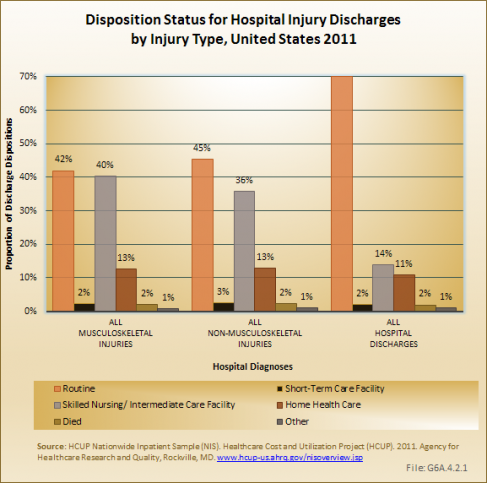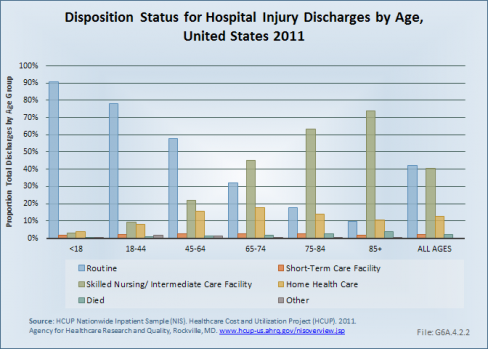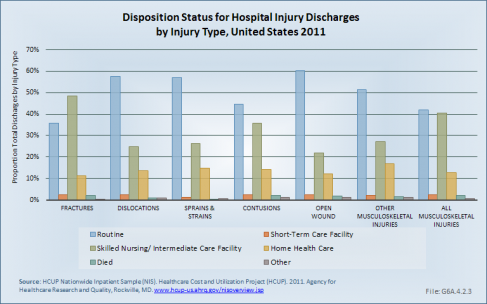

Hospital charges are only part of the cost burden associated with musculoskeletal injuries. Nearly one-half of people discharged from a hospital following an injury are discharged to another type of care facility, such as a short-term, skilled nursing, or intermediate care facility. Still another 13% receive home health care following discharge. These ratios are substantially higher than for all hospital discharges, where 70% of patients are discharged to home without additional care.
Age is clearly a factor in the type of hospital discharge received. By the age of 85 years and older, only 10% of hospital discharges for musculoskeletal injuries are to home without additional home health care, with 76% being discharged to another type of care facility and 10% receiving home health care. With the exception of those under the age of 18 years, fracture injuries are the most likely to result in discharge to additional care. After the age of 45 years, fractures to the lower limb are most likely to result in discharge to additional care, while for those younger than 45 years, a torso fracture is the most likely diagnosis to require additional care. (Reference Table 6A.4.2.1 PDF [1] CSV [2], Table 6A.4.2.3 PDF [3] CSV [4], and Table 6A.4.2.5 PDF [5] CSV [6])


Among those seen in an ED for injury treatment overall, 8% to 9% are admitted to a hospital for further care. About 1% will be sent to a skilled nursing or intermediate care facility. Again, as the age of the patient increases, so does the likelihood of being admitted to the hospital from the ED or being sent to a skilled or intermediate care facility. Very few patients are referred to home health care from the ED. Type of injury follows the same pattern as hospital discharges, with fractures the most likely type of injury to require additional health care outside the ED. Fractures to the torso result in more hospital admissions than upper or lower limb fractures overall, but lower limb fractures for persons age 65 years and older account for more hospital admissions. (Reference Table 6A.4.2.2 PDF [7] CSV [8], Table 6A.4.2.4 PDF [9] CSV [10], and Table 6A.4.2.6 PDF [11] CSV [12])
Links:
[1] https://bmus.latticegroup.com/docs/T6A.4.2.1.pdf
[2] https://bmus.latticegroup.com/docs/T6A.4.2.1.csv
[3] https://bmus.latticegroup.com/docs/T6A.4.2.3.pdf
[4] https://bmus.latticegroup.com/docs/T6A.4.2.3.csv
[5] https://bmus.latticegroup.com/docs/T6A.4.2.5.pdf
[6] https://bmus.latticegroup.com/docs/T6A.4.2.5.csv
[7] https://bmus.latticegroup.com/docs/T6A.4.2.2.pdf
[8] https://bmus.latticegroup.com/docs/T6A.4.2.2.csv
[9] https://bmus.latticegroup.com/docs/T6A.4.2.4.pdf
[10] https://bmus.latticegroup.com/docs/T6A.4.2.4.csv
[11] https://bmus.latticegroup.com/docs/T6A.4.2.6.pdf
[12] https://bmus.latticegroup.com/docs/T6A.4.2.6.csv